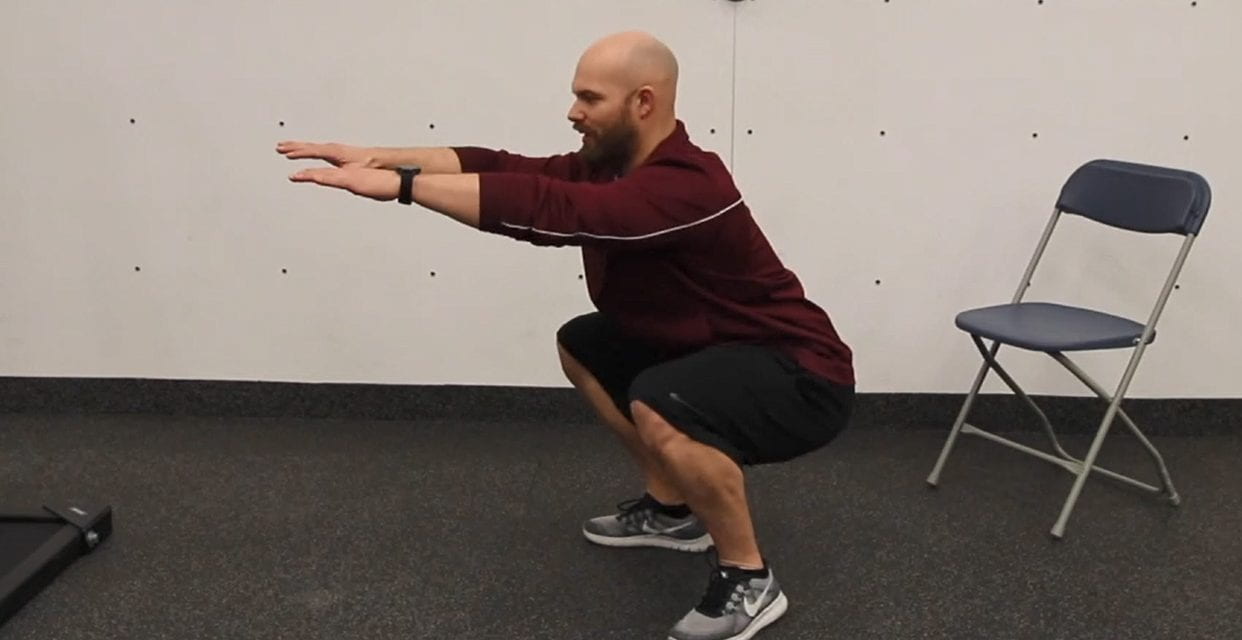The squat is a fundamental human movement pattern that incorporates the coordinated contractions of lower-body muscle groups (i.e. quadriceps, glutes, adductors, calves) and the core (i.e. abdominals, erector spinae). With proper technique it can help improve one’s strength, power, mobility and overall performance in a variety of physical activities. Working through a full range of motion, over time the squat movement can also help to counteract the effects of chronic musculo-skeletal issues such Kyphosis & Lumbar Lordosis, often a result of weakened glute and core muscles and prolonged poor movement patterns.
Objective
- The objective when squatting is to move the body in a smooth coordinated hip-hinge knee bend movement, with an emphasis maintain on a neutral spine, upright trunk and an evenly distributed weight displacement
Joints Targeted
- In the bodyweight only version the hips, knees and ankles and primary. Once you add the extra resistance of a barbell, the shoulder and elbow joints also come into play.
Muscle Groups Targeted
- Agonists
- Quadriceps femoris
- Gluteus maximus
- Adductor magnus
- Soleus
- Stabilizing muscles
- Erector spinae
- Rectus abdominus
- Internal/external obliques
- Hamstrings
- Gluteus minimus/minimus
- Gastrocnemius
Starting Position
Modified Squat (Chair squat)
- Stand in front of a chair, feet flat and about hip width apart, toes pointed slightly out, head up, back straight, arms bent with hands clasped below just below the chin
Modified Squat (Air & Prisoner squat)
- Stand with your feet flat and about hip width apart, toes pointed slightly out, head up, back straight and yours arms extended out in front at shoulder height parallel to the floor (for an air squat technique) or arms bent at shoulder height with fingers connecting at the base of your scull (for a prisoner squat technique)
Movement
- In a controlled manner with your head and chest up, spine in neutral brace the core as you hip hinge by pushing the hips back
- As you hinge at the hips bend your knees to 90 degrees (or lower if you have the mobility)
- Pause in the bottom position then press your feet into the floor along the big toe to the outside of the heel to engage the glutes and return to the standing position
Recommended sets and repetitions
- For Bodyweight squats start with 3 sets of 10 reps
- Once you progress to adding extra resistance you can switch to performing 3-5 sets of 3-4 reps if your focus is to improve max strength or 3-5 sets of 10 if your focus is to improve strength endurance
Progressions
- Option 1 – manipulate tempo of lift. To increase difficulty doing bodyweight only squats slow down the tempo of each rep
- Easy = 2 sec eccentric (relaxation of muscle or downward motion) – 1 sec pause (at the bottom of the movement) – 2 sec concentric (contraction of muscle or upward motion)
- Harder = 5 sec eccentric – 3 sec pause – 5 sec concentric
- Option 2 – add resistance. Increase difficulty by holding a weight in front of you at chest height (i.e. goblet squat), holding a weight such as a BB plate on your head (i.e. plate squat)
By Kyle and Terra
Terra is a Bachelor of Physical Education Graduate and is certified with the Canadian Society for Exercise Physiology. She is currently the Supervisor of the Fitness Area and the resident triathlon coach. She specializes in detailed and technical training programs for endurance activities such as triathlon, running and cycling.
Kyle is a Bachelor of Kinesiology Graduate and is certified with the Canadian Society for Exercise Physiologists. He specializes in movement analysis, chronic disease management through exercise and strength programming. He’s worked with athletes, individuals with chronic diseases, along with many other individuals trying to achieve their health and fitness goals.


